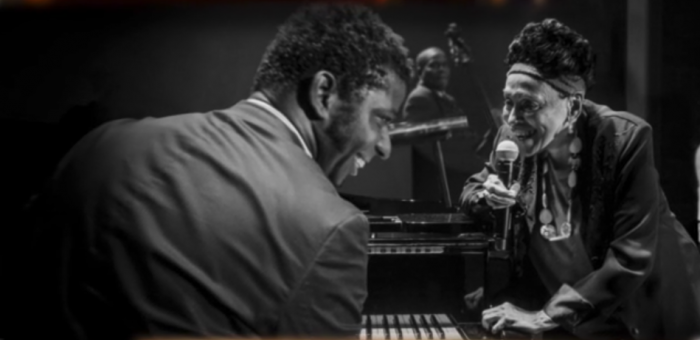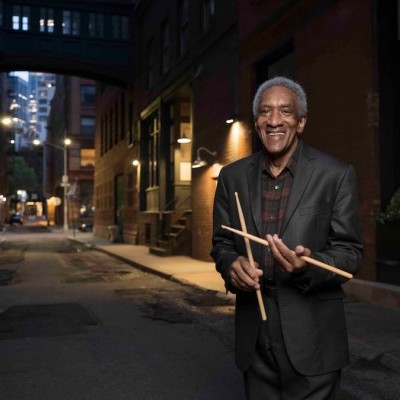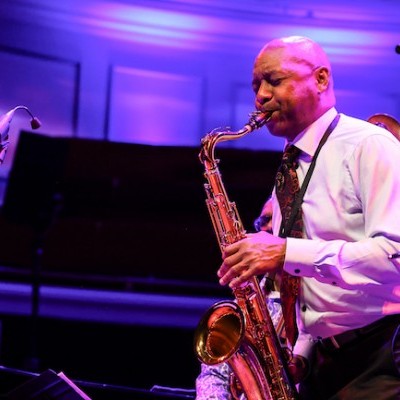Jun 3, 2025 11:25 AM
In Memoriam: Al Foster, 1943–2025
Al Foster, a drummer regarded for his fluency across the bebop, post-bop and funk/fusion lineages of jazz, died May 28…

Omara Portuondo and Eliades Ochoa from The Buena Vista Social Club.
(Photo: Montuno Producciones, S.L)It begins with a mention of the late Fidel Castro, the leader of Cuba’s 1959 revolution. Thus, the sides are drawn, politically, in what should be viewed as a celebration of this great island nation’s emergent history and ongoing, incredible cultural contributions to the world.
A summer 2017 worldwide release, the film Buena Vista Social Club: Adios is a follow-up to the 1999 film Buena Vista Social Club, an international co-production directed by Wim Wenders with much assistance from Ry Cooder. Running just under two hours, this new feature-length documentary charts the history of Cuba and Cuban music, with insightful commentary and, of course, splendid performances galore.
Named for a danzon, the Buena Vista Social Club recorded a Grammy-winning album by the same name in 1996 that inspired the original documentary. Adios begins with the origins of the club itself, narrated by member Juan de Marcos. We see the present-day setting where there was once a thriving club scene and “a society for black people”—it’s now the site of a modern gym. There’s a definite whimsical element to everything that follows, the tributes to many 20th-century Cuban masters of what was essentially son music both loving and informative.
“The golden era of Cuban music” spanned the decades of the 1940s and ’50s. Adios traces the original lines that were formed as Spain invaded Cuba, slavery was introduced and the musical elements coming from Europe and Africa merged to create the melting pot of a new musical form. We learn of Cuba outlawing slavery in 1886, but also how the conga drums were still a banned instrument up until the 1940s.
This new Wenders/Cooder production has choice clips of historic artists like Arsenio Rodriguez, Compay Segundo and Ibrahim Ferrer performing for television and elsewhere, mostly in black and white. A hilarious Winston cigarette commercial, featuring Club member Omara Portuondo in an all-girl singing group, adds to the charm.
Serving as a kind of extension of the original documentary, Adios takes us for brief visits to New York City’s Carnegie Hall, Ronnie Scott’s club in London and to Amsterdam, as the players enjoy their better-late-than never (1998) worldwide celebrity status, performing before adoring audiences.
We get to see the ends of the island, Santiago and Havana, serving as hubs, with Havana having the lion’s share of clubs and thriving night life. That was up until the revolution and Castro’s mixed reactions to this music, a music which was both vital to the society’s vibrant tourism and which represented much of what the revolution stood against. The film doesn’t dwell on this but gives the impression that the musicians were behind their new leader and his shift to a new political climate. There is also an open-eyed look at how some musicians struggled to make ends meet despite the ongoing, deleterious effects of racism.
Adios also conveys the heartwarming reality of when the Buena Vista Social Club performed at the White House in 2015 with President Obama, and when Obama visited Cuba in 2016, not to mention the group’s performance in London’s Hyde Park.
The legendary 19th-century Cuban writer/poet José Martí is invoked in another loving context, pointing to the spirited and joyous, if arduous, legacies that the Buena Vista Social Club called forth: “Music is closer to the true world than the material world.”
Among the highlights of the Buena Vista Social Club: Adios documentary is a focus on pianist Ruben Gonzalez, an integral member of this now-transient musical aggregate. Originally recorded at the same time as the original Buena Vista Social Club album in 1996, Introducing Ruben Gonzalez (World Circuit) finds this amazing virtuoso finally debuting as a solo artist at age 77 after having first recorded with Arsenio Rodriguez’s classic band back in 1943.
This reissue, which sold more than a half-million when it was first released, includes two extended and one unreleased track, and is also available in a 180-gram vinyl format. Along with the notoriety that the Buena Vista Social Club generated, Introducing Ruben Gonzalez served as a kind of late-career boost for an artist who, at the time, no longer had a piano, due to wear and tear, and was suffering from arthritis. He died in 2003.
Clearly, Gonzalez sounds ageless, inspired on all 10 of the tracks here, playing solo but also with other Club musicians, including bassist Orlando “Cachaito” Lopez, timbale player Amadito Valdes, bongo player Roberto Garcia, conga player Carlos Gonzalez and trumpeter “Guajiro” Mirabal. One would never guess there was anything holding Ruben back, physically or otherwise, at this late date. With no rehearsal, this is a collection of classic Cuban material played in a descarga/jam-session style, a combination of lovely and endearing melodies coupled with alternately entrancing and rhythmically dazzling workouts. DB

Foster was truly a drummer to the stars, including Miles Davis, Sonny Rollins and Joe Henderson.
Jun 3, 2025 11:25 AM
Al Foster, a drummer regarded for his fluency across the bebop, post-bop and funk/fusion lineages of jazz, died May 28…

“Branford’s playing has steadily improved,” says younger brother Wynton Marsalis. “He’s just gotten more and more serious.”
May 20, 2025 11:58 AM
Branford Marsalis was on the road again. Coffee cup in hand, the saxophonist — sporting a gray hoodie and a look of…

“What did I want more of when I was this age?” Sasha Berliner asks when she’s in her teaching mode.
May 13, 2025 12:39 PM
Part of the jazz vibraphone conversation since her late teens, Sasha Berliner has long come across as a fully formed…

Roscoe Mitchell will receive a Lifetime Achievement award at this year’s Vision Festival.
May 27, 2025 6:21 PM
Arts for Art has announced the full lineup for the 2025 Vision Festival, which will run June 2–7 at Roulette…

Benny Benack III and his quartet took the Midwest Jazz Collective’s route for a test run this spring.
Jun 3, 2025 10:31 AM
The time and labor required to tour is, for many musicians, daunting at best and prohibitive at worst. It’s hardly…